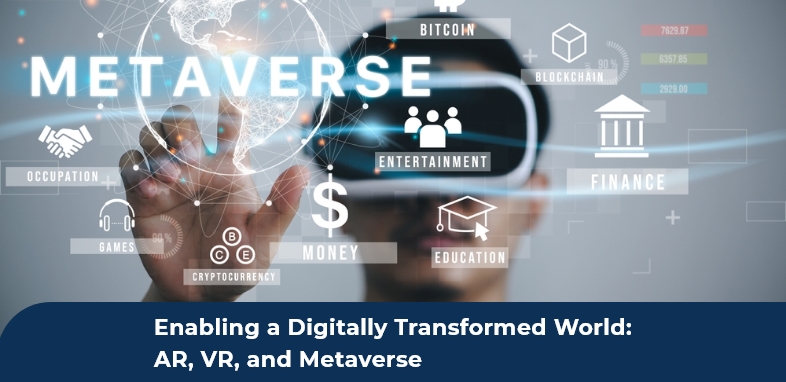Digital Transformation is certainly a journey and not a destination. In the post-pandemic era, we have seen many of us use virtual, augmented, and mixed-reality technology for work and play, laying the foundation for what is known as the human edge.
Technology that combines real-world information with digital information is known as augmented reality (AR). Users of virtual reality systems (VR) are immersed in synthetic virtual environments. The ability to create immersive metaverses enables personal digital avatars to interact and perform actions that are limited only by what the programmer can imagine. It’s only just begun to reveal the possibilities of these new digital realities, with use cases such as training, warehouse work, and data visualization already gaining traction.
A major advantage of augmented and virtual reality for businesses is that it improves every business process, including product, design, production, warehousing, admin & management, marketing, service, and retail. AR and VR applications will prosper and be driven by the upcoming revolutions in ultra-wideband 5G and multi-access edge computing (MEC), which might be significant facilitators of applications that require high performance and low latency.
Technologies enabling Digital Transformation
The global VR and AR market was valued at $27B in 2018. And by 2025, it is expected to reach $393B with a CAGR of 69.4% during 2019-2025. According to Bloomberg Intelligence, the market for Metaverse technology is anticipated to be worth $800 billion by 2025 and might potentially reach the $2.5 trillion level by 2030. In order to alter both AR/VR technology and the future, the sector has been receiving the external stimulation of attention it requires.
Let’s take a look at some of the technologies that are bringing order to this space’s chaos.
Augmented Reality & Virtual Reality (AR / VR)
The foundation of any metaverse endeavour is AR and VR. Three fundamental components—coupling the actual and virtual worlds, real-time interaction, and accurate 3D object visualization—underlie how augmented reality systems work.
Since AR apps can be downloaded and used on any camera-enabled device, they have a higher acceptance rate than VR apps. AR enriches objects with immersive components that increase information.
While VR is totally simulated and takes place in a digitally created world, the former is not. It is employed to provide sensory experiences that are on par with the user’s physical reality. Due to the additional hardware required, such as a head-mounted display or multimodal projection screen, VR systems are slightly more expensive than AR systems.
Artificial intelligence (AI)
The study of artificial intelligence as a field of study is now mature. Whether it is automated decision-making systems, self-driving cars, or recommendation algorithms, it has numerous uses in the commercial world.
AI can also be used by developers to give realistic effects to images through image categorization, facial recognition, and advanced computer imaging.
Internet of Things (IoT)
A real-time simulation requires real-time data, which is why billions of gadgets have been connected to the Internet of Things to gather real-time information. We can use this feed to make simulations come to life in the metaverse. Data integration and interaction can be seamless with IoT and AI, ML, and 5G.
Metaverse
According to Facebook, the Metaverse would combine the real world and virtual worlds, allowing for peer-to-peer, lifelike interaction in virtual workplaces. Collaborations would mimic actual situations where AR and VR components would be combined to let people experience conditions that are not constrained by the laws of physics (perhaps). On the metaverse, you might theoretically engage in any activity, including traveling, playing, working, and running.
Many futurists consider the current state of the web to be riddled with gaps and insurmountable chasms. According to them, the metaverse could serve as the unifying force that creates interoperable, multisensory, and economically feasible conditions.
VR, AR, and Metaverse: Redefining the World
Metaverse Technology is definitely the next big thing in the AR/VR world. In reality, the metaverse is not just a buzzword but a rapidly emerging virtual reality. Facebook’s long-term commitment to becoming the Mecca of metaverses captivates us all. However, the question is how many digital universes will be structured after emerging from a loud and big bang.
There are aspects of AR and VR that are intertwined in the Metaverse technology. The Metaverse app is expected to resemble the real world in terms of space and time. It is possible to interact visually, auditorily, and dynamically in the real world. Metaverse platforms are expected to deliver experiences similar to that of digital collaboration.
Wrapping up
AR, VR, and MR are making significant advancements in industries including healthcare, construction, business, and even entertainment.
The benefit of augmented reality, virtual reality, and the metaverse are arguably the greatest. The sooner you act, the better. When you simulate in advance, you have time to prepare. We have all strived for this in our businesses, haven’t we?
About the Author:
 Prashant Deshpande
Prashant Deshpande
Executive Vice President
Prashant heads global delivery of Vyom Labs consisting of various practice units such as BMC and ServiceRize. Prashant has illustrious career over thirty years in information technology and has served at senior executive levels with global companies such as: IBM, BMC, Veritas and Citibank.
Prashant has built, scaled and managed various IT, professional services & product development/support organizations.
His technical expertise is in IT infrastructure management, automation and managed services. He is passionate about business transformation using cognitive technologies such as AI and machine learning.
